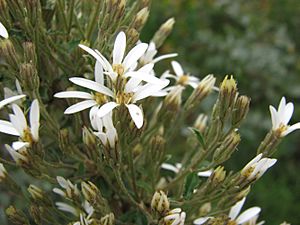Moth daisy-bush facts for kids
Quick facts for kids Moth daisy-bush |
|
|---|---|
 |
|
| Olearia erubescens in Kinglake National Park, Victoria |
|
| Scientific classification | |
| Genus: |
Olearia
|
| Species: |
erubescens
|
The Moth Daisy-Bush (Olearia erubescens), also sometimes called the Pink-Tip Daisy-Bush, is a type of flowering plant in the Asteraceae family, which includes daisies. This plant is a shrub that can grow up to 2 metres (about 6.5 feet) tall. It has stiff, somewhat prickly leaves and pretty white flowers that look like daisies.
What Does the Moth Daisy-Bush Look Like?
The Moth Daisy-Bush is a woody shrub that spreads out. It usually grows between 0.5–2 m (1.6–6.6 ft) tall and 0.5–1 m (1.6–3.3 ft) wide in lower areas like grasslands. If it grows in higher, colder places, it might be smaller, around 40 cm (16 in) high.
Its young branches are covered in soft, whitish, T-shaped hairs. The top of the leaves is smooth, dark green, and stiff. You can see a clear network of pale veins on them. The leaves grow on short stalks, about 11 mm (0.43 in) long. They are arranged one after another along the stem and end in a sharp point.
The leaves are shaped like a narrow oval or oblong. They are about 15–125 mm (0.59–4.9 in) long and 3–20 mm (0.12–0.79 in) wide. They have small, rough, uneven teeth or slightly lobed edges. The underside of the leaves is covered with thick white hairs. Sometimes, when they are new, these hairs can look a bit reddish.
The plant produces clusters of 4 to 8 white flowers. Sometimes, these flowers can have a pinkish-purple tint. Each flower is about 15–31 mm (0.59–1.2 in) across. They bloom at the end of branches on a stem called a peduncle, which is about 1–4 cm (0.39–1.6 in) long. The center of the flower is yellow. The flowers usually appear from September to January. After flowering, the plant produces small, dry, ribbed fruits, each containing one seed.
How Did It Get Its Name?
The Moth Daisy-Bush was first noticed by a person named Franz Sieber. He called it Aster erubescens. However, he didn't officially publish this name. Later, in 1826, Curt Sprengel published the description in his book Systema Vegetabilium.
Then, in 1889, Leopold Dippel described the plant as Olearia erubescens. He published this name in his book Handbuch der Laubholzkunde.
The second part of its scientific name, erubescens, comes from a Latin word. It means "to grow red" or "to blush." This name might refer to the new growth on the plant, which can sometimes have a reddish color.
Where Does the Moth Daisy-Bush Grow?
The Moth Daisy-Bush is a common plant found along the coast and mountain ranges of Australia. In New South Wales, it grows from the Blue Mountains west to places like Orange and Drake.
You can also find this plant in South Australia, Victoria, and Tasmania. It likes to grow in rocky areas, dry forests (called sclerophyll forests), woodlands, and mountain forests.

